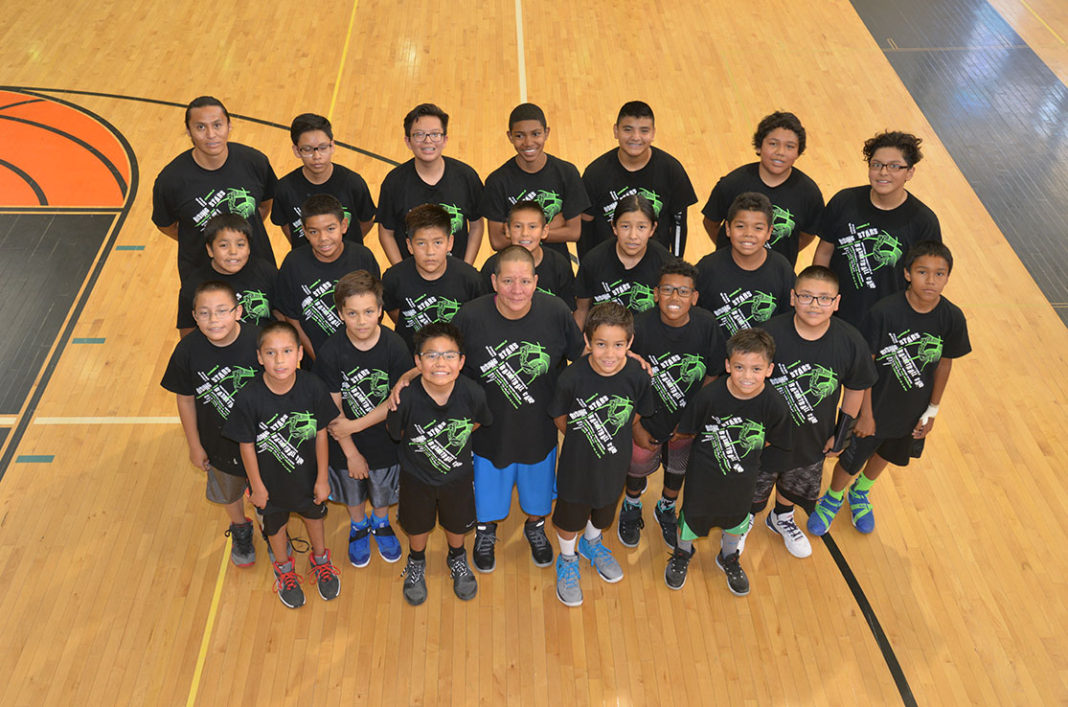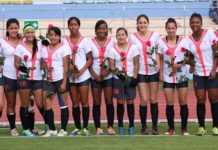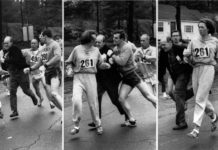The first Native American player for the WNBA remembers the “celebrity shock” she experienced in 1997 as she walked into the locker room of the America West Arena, now known as Talking Stick Resort Arena. A new player and point guard for the Phoenix Mercury and for coach Cheryl Miller, Ryneldi Becenti, now 44, met player after player who she admired such as Michelle Timms, considered to be one of the best basketball players to come from Australia. Many told Becenti they’d heard of her and seen her around. But Becenti also recalls her inner monologue. She struggled to believe anyone knew her, a young woman from a small town who just loved to play basketball.
Hear more about rez ball, a “run-and-gun” style of basketball played by Natives.
Back home in Fort Defiance, Arizona, a town of about 3,624 on the Navajo Nation, the largest Native American reservation in the United States, Becenti grew up playing the game with her brothers and dreaming of this moment. She and her four brothers used commodity flour to mark the lines of a basketball court in the dirt – out of bounds, half court, free throw lines, and three-point arcs. When the “rez dogs,” stray dogs or outdoor dogs living on Native American Reservations, licked those lines, they had to remark them.
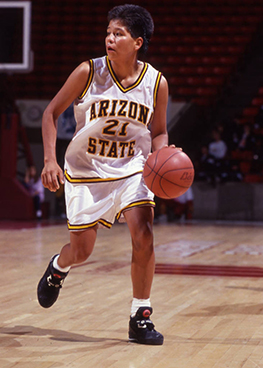
As an eighth-grader, after her mother died of cancer, her father asked her to write down her career goals. She handed her father a piece of paper that spelled out her dreams: be the first Native American basketball player, make a name for her town, win a state basketball championship, play in the Olympics, and play pro basketball. “Are you fucking stupid?” she remembers her father saying jokingly as he read her list. Then he crushed the paper in his hands. “These aren’t goals! Come up with some real goals!” In that moment, the young athlete decided to prove to her dad — and everyone else who doubted her — wrong.
And she did. The former All-American racked up an impressive basketball résumé with many firsts for woman in general and Native American women in particular: the first and only female inducted into the American Indian Athletic Hall of Fame, Arizona High School Sports Hall of Fame, Scottsdale Community College Hall of Fame, Arizona State University Hall of Fame, and the first women’s basketball player to have her jersey retired at ASU. You can find her old games only on VHS tapes today. But in 1993, Gary Smith of Sports Illustrated described Becenti’s ability to control the “pulse” of the game even under pressure. “She stood out as the true natural, moving the ball casually between her legs and behind her back, cross-dribbling on the fly, seeing everything without seeming to look—bang!—suddenly the ball was in a teammate’s hands beneath the hoop,” he wrote.
Twenty years later, the former point guard still touches a basketball each day. When she’s not in nanny mode helping to care for a friend’s three kids, she’ll flip through a local newspaper, flip through it, and see what youth basketball camps and clinics are going on around Shiprock, N.M., her current home on the Navajo Nation. Sometimes Becenti shows up unannounced and ready to help Native youth improve their game. And camp organizers welcome it. Other times, she calls ahead to see if she can help the camp organizers. “Most kids don’t know about me and older adults would tell them,” she says. “Some of them will Google me and say, ‘Oh! Crazy!’”
“She had all the skills. She could shoot it. She could drive. She could defend. In that little body, that five-foot-seven body, she had had every basketball skill.”
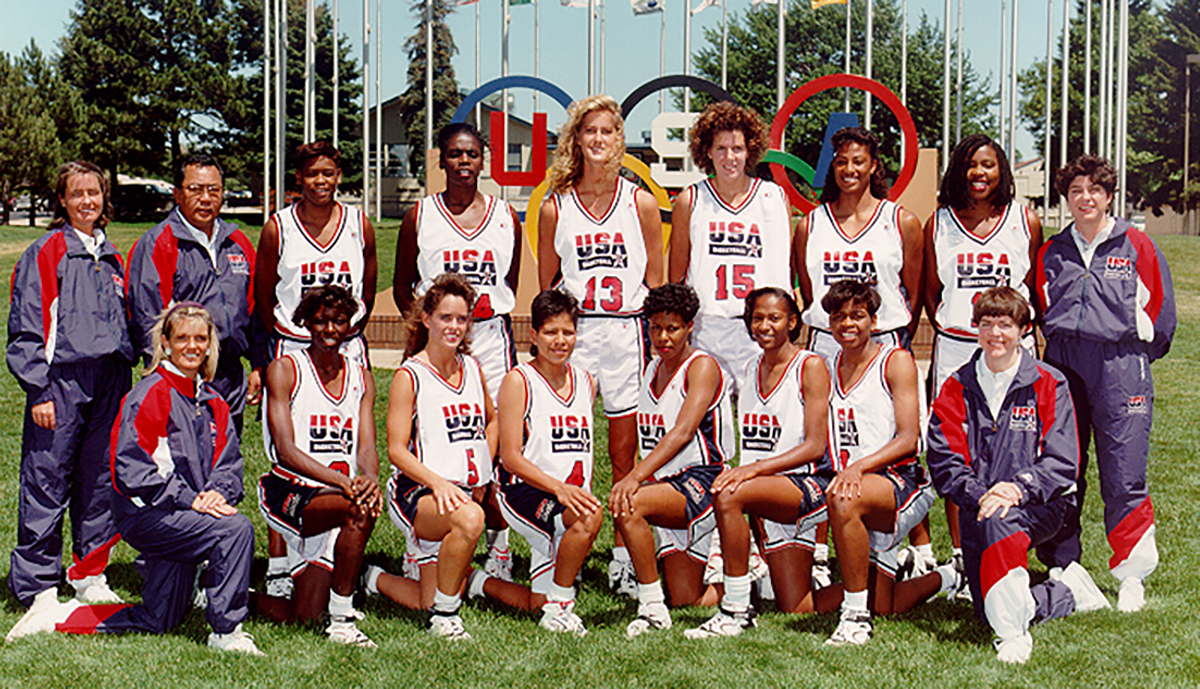
From the 1990s and well into the 2000s, Becenti has been the only Native American woman to make it to the WNBA. In addition to the Mercury, Becenti played for the Sacramento Monarchs and Portland Fire. Both teams folded in the early 2000s. For years, the WNBA evolved and expanded without a Native presence. But in 2011, three more Native athletes made their way into the league. Tahnee Robinson, citizen of the Northern Cheyenne, Sioux, Pawnee, Eastern Shoshone tribes, was drafted in 2011 to the Phoenix Mercury and later played for the Connecticut Sun. In 2013, the Tulsa Shock picked Angel Goodrich, citizen of the Cherokee Nation of Oklahoma. In 2014, Shoni Schimmel, citizen of the Confederated Tribes of the Umatilla, became the highest-drafted Native American, selected eighth overall, into the WNBA. Goodrich was released in May from the Seattle Storm. Currently, Schimmel is the only one representing Indian Country, and shares much with Becenti. “Oh gosh. [Becenti] actually reminds me a lot of Shoni Schimmel, but with more control. It just flowed out of her,” says Nadia Begay-Watson, who played Division I basketball at Boise State University. “When she dribbled smoothly, she just knew where everybody was. Her shot, flawless.”
Begay-Watson, who was on the route to the WNBA after college but burned out, remembers meeting Becenti when she was a kid. Becenti’s approachability made her likable. “She was just everything I wanted to be. I wanted to be in the WNBA. I wanted to take my basketball career to the next level, and she was a prime example,” she says. Her coach at Scottsdale Community College, Bike Medder, recalls Becenti’s “super high basketball IQ” during her two seasons with him. “She had all the skills. She could shoot it. She could drive. She could defend. In that little body, that five-foot-seven body, she had had every basketball skill,” he says. “If she played today, she’d be one of the best players in the country – at any level. She was that good.” She had a knack for putting on a show without trying to do so. It came naturally. To him, Becenti is still the greatest Native American basketball player among girls, boys, women, and men.
“A lot of us use [basketball] as therapy: to get away and let loose, to forget problems or issues, or stress. We get out there and play and, in a sense, be free.”
Rainy Crisp, an Arizona State University basketball star, says basketball is huge among Native American communities, especially among Native youth. “A lot of us use it as therapy: to get away and let loose, to forget problems or issues, or stress. We get out there and play and, in a sense, be free,” she says. “It’s just something we’ve all grown up with. Our grandparents played it, our parents played it. For all of us, it’s pretty much in our blood.” However, Native communities play a different version of basketball called “rez ball.” It’s repeatedly described as a “run-and-gun” play of basketball focused on pushing the ball up the court to beat the opponent and shoot three pointers. It’s a lot of running. No plays are involved and it focuses on improvisation. As told by Robinson, it’s because of rez ball that Natives are known to shoot really well. “I would think that because we do start playing at a young age that our basketball IQ is a little bit higher than other people, so it’s just that we know how to play.” Like the local Navajo basketball greats – Becenti, Gwynn Grant (now Gwynn Hobbs), Nadia Begay-Watson, Rainy Crisp, and Jaimey Tanner – Native youth look to basketball as the “ticket” off the rez so they can see the world, receive an education, and succeed. Sherman Alexie, an infamous Native American novelist, describes basketball as a “poverty game” and “poor people’s game,” all you need is something resembling a ball and a basketball hoop. Becenti’s father carried an iron rim in the back of his truck so his kids could play in the mountains when they hauled wood. As Crisp and many young Native players learned to play basketball, Alexie learned and loved the game because his father played it. “It’s probably just natural for us just to play,” Crisp says.

Becenti stays involved with the basketball circuit by engaging Native communities in the accomplishments of its basketball stars and aspiring basketball players through social media. In February Facebook post, she encourages all “ballers to train, focus, prepare, practice and work hard” and it takes “a basketball, effort, determination, and dedication from you and you only. It’s about love and basketball, and excuses are not the way to go. “It’s inspiring for the kids to know there’s still hope. All the young, good kids could be inspired, motivated, determined, and want to go out and be somebody in the next three or five years,” she says of the recent surge in Native American pro basketball players. “I feel we could make a big impact.” Becenti shares her experiences playing at a Division 1 level, in Europe, and for the WNBA across Diné Bikéyah, or The Land of The People, and other reservations with Native youth who aspire to play basketball at the high school, college, and pro level. Community members in Shiprock can find her at Diné College during open-gym times playing or coaching young players. Crisp, now a volleyball and basketball coach at Navajo Preparatory School, who met Becenti nearly 15 years ago in Tempe, Arizona, says the basketball star will work with anyone. Becenti has helped with Crisp’s basketball camp for 10 years as part of the Rising Stars Camps at Navajo Preparatory School in Farmington, New Mexico, 25 minutes east of Shiprock. “Yesterday, she had 20 kids at the gym when she was volunteering,” Crisp says. “She’s a whole different person when she coaches.” Athletes around Shiprock, famously known as Tse’Bit’Ai, will text her asking her if she can meet them at the gym for some basketball pointers or workouts. She constantly reminds the student-athletes that “I am available to help you and practice with you. I’m all for it, but I’m not going to chase or beg you.” Basketball coaches and parents frequently ask her to put on a camp for free during the weekends. She often agrees because coaches, parents, or community members “don’t put on camps [on the Rez].” She warns that her camps are intense and focus on agility, footwork, and tons of drills.
For Becenti, the pivotal moment in her career, arrived shortly after her mother died, and it’s a story she often shares with parents and others who coach young players.
Out of the coaches and camp leaders, students favor Becenti’s story the most, Crisp says. “They love the funny stories she has about herself and the embarrassing moments that she had,” Crisp says. One of which includes an Olympic-size swimming pool at ASU. One of the team’s workouts involved swimming 10 laps breaststroke style. The first time Becenti was asked to do that, she looked at Coach Cheryl Miller, a former standout at the University of Southern California, confused and said, “I know how to swim, but I don’t know how to swim in this big pool.” Miller replied, “You don’t have swimming pools on the rez?” Becenti jokingly responded, “No. We just have a wash and that wash only comes when it rains. We just jump in there, and that’s as far as we got for a pool.”
As she drives across the Navajo Nation and other reservations sharing her stories, giving motivational talks, and spreading her basketball secrets with players, Becenti also shares her intense training schedule — getting up at 6 a.m. for drills in the morning, a two-hour break to eat and rest, weight lifting, drills for the guards in the gym for two hours, and then swimming laps. “You’re constantly doing something, but at the same time you have to learn to take care of your body,” she says. For Becenti, the pivotal moment in her career, arrived shortly after her mother died, and it’s a story she often shares with parents and others who coach young players. Looking back, Becenti realizes that she struggled with depression after her mother died. Her dad knew it, and he tried to help. He told his daughter to go talk to her mom and to come back home when she finished. The following day for eight consecutive hours, the young girl spoke to her mom and cried at her grave. “I let out everything,” Becenti says. Not long after that conversation, she felt her mom’s presence on the basketball court when a whirlwind consumed her. “My life changed in that moment,” she says. “From then on, I was going to do everything for my mom.”
Even though Becenti has shifted most of her attention from playing to coaching and inspiring young Native players, she continues to play and to win.
Now, she’s also lost her dad, who always told her that after she finished experiencing the world, she would come back and teach the kids what she learned. It’s a directive she continues to follow. “She’s the hero of the reservation,” Maura McHugh, Becenti’s ASU basketball coach, told Smith of Sports Illustrated. “They hold their breath with every move she makes. She feels such pressure to be the perfect role model, to make every game the perfect game. They come from so far to see her, they call her on the phone all the time. She’s a walking Dear Abby column, in reverse—all of her people want to give her advice. Their fear is that she won’t go back to them, that she has become too modern. My fear is that she’s under so much pressure to please everybody that she won’t please herself.”
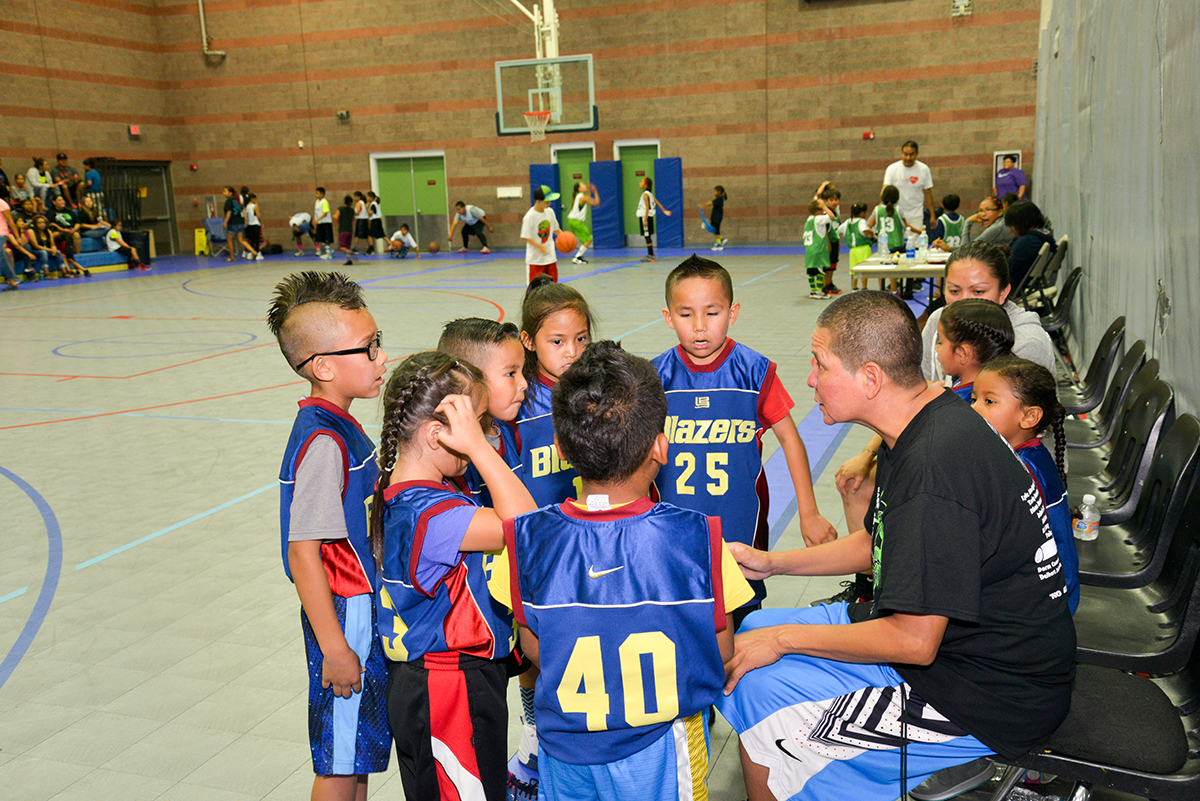
But Becenti continues to give to her community. For years, Becenti has taken a group of high school basketball players to Phoenix, Arizona for the Native American Basketball Invitational, a tournament many hungry and determined basketball players play at in hopes of getting recruited to play college ball. “We deserve a lot more respect in having more college recruiters come out. I’ve seen some really talented ball players, girls and boys,” she says of the college recruiters looking at Native athletes. NABI gave Angel Goodrich of the Seattle Storm her exposure, according to GinaMarie Scarpa, co-founder and president of the NABI. Even though Becenti has shifted most of her attention from playing to coaching and inspiring young Native players, she continues to play and to win. Last year, she played in the 13th Annual Charles H. Billie Sr. Memorial Tournament in Florida with Tahnee Robinson (the second Native player to reach the highest professional league for female players) and Crisp, and won it. Robinson, pursuing her master’s degree at the University of Nevada in Reno, didn’t get the chance to watch Becenti play in the WNBA. But because she grew up playing in tournaments with older Native women, she remembers them talking about Becenti’s skill as a passer and how smooth she was on the court. “The thing is,” Crisp says of Becenti, “she loves the sport of basketball. I don’t know when she’s ever going to stop playing basketball.” Some people, like Tonya Johnson, who played in tournaments against her after the WNBA and a couple of months ago, says everyone knows she will retire. And they — her former teammates, other Native players, and all those “rez dogs” like Becenti herself, playing on dirt courts with commodity-flour lines and nursing hoop dreams — don’t want that to happen.


